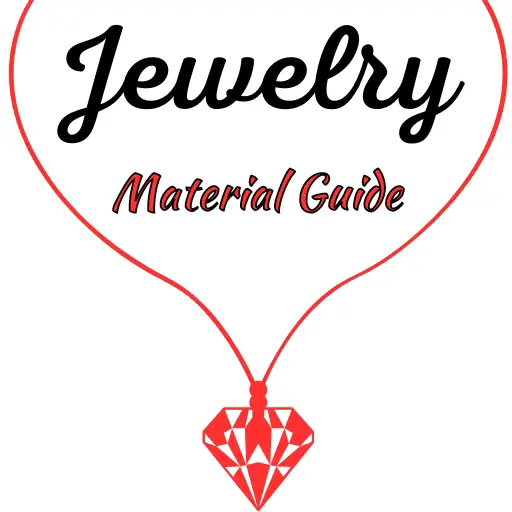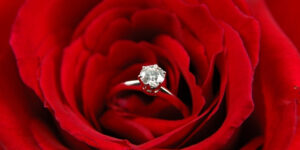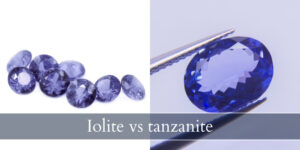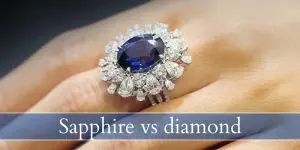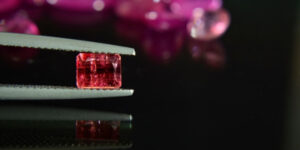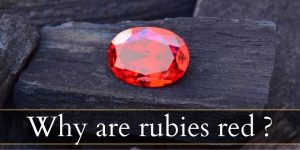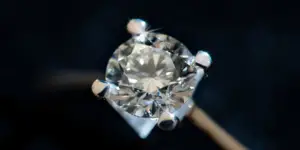Square-shaped diamonds are a refreshing change from the usual round-cut brilliant, but they can quickly become overwhelming when you try to find the perfect one for your ring. Two square shapes you will bump into are the Asscher cut and the cushion cut. One is a step cut, one is a brilliant or mixed cut, one has more sparkle while the over is more angular.
Both would look great in an engagement ring but they offer very different looks. So let’s compare the two and see which you’d like best for your engagement ring.
Asscher vs cushion cut
Asscher cuts are very geometric and angular compared to cushion cuts. Cushion cuts have rounded corners and sides while Asscher cuts have straight edges with very clean lines and clear, mirroring facets. Cushion cuts have brilliant facets that are designed to maximize sparkle while Asscher cuts have less sparkle but have more emphasis on clarity and color grade.
The Asscher cut is less popular, less expensive, and much rarer than the cushion cut so you will need to search for your perfect diamond longer but you can get it at a more affordable price.
What is Asscher cut ?
The Asscher diamond cut is a step-cut style what has many wide facets facing each other, forming a hall of mirrors effect. Its overall shape is a square with clipped corners and a very angular appearance. The Asscher cut is sometimes called a squared emerald cut, although there is a difference between Asscher and squared emerald cuts.
An Asscher cut’s defining feature is its 4 facet rows that come down from the corners to the center, forming a large X or windmill. A squared emerald is not as perfectly square as an Asscher and its corner facet rows do not meet in an X, instead they meet in a V.
There is a lot of confusion regarding Asscher cuts, as the original cut was invented and patented in 1902 by Joseph Asscher. The patent for the Asscher cut expired during WW2 while the entire Asscher family and all of their master polishers were interred in concentration camps.
So, many competitors developed their own Asscher cuts, some even using the same name and some naming their cuts a squared emerald. Today the Asscher family thrives and is at the help of the Royal Asscher Diamond Company and has renewed the Asscher cut patent, along with a few more.
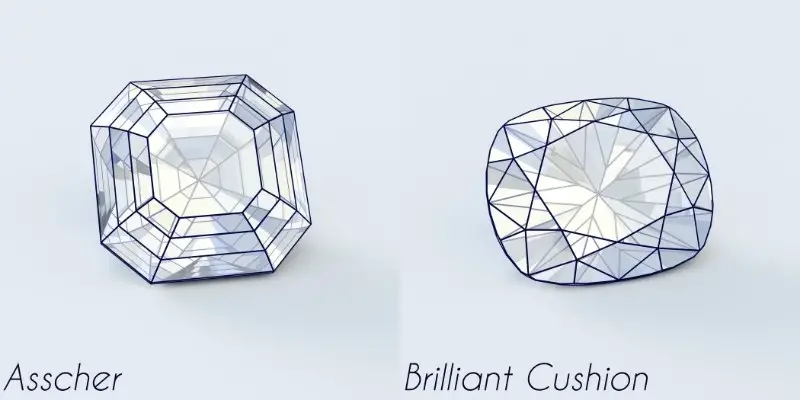
What is cushion cut ?
The cushion cut is a brilliant cut style, derived from the old mine cut. It’s almost a square shape, though it’s usually a bit elongated. The cushion cut has rounded edges and rounded corners, appearing like a cushion or pillow, hence the name.
This cut style is very popular and has quite a few variations, the most popular being the crushed ice cushion cut. This variation has more facets on the pavilion, smaller ones, and because of this it gives more of a crushed ice look, so more brilliance than fire.
Cushion cuts are very popular in halo settings, and work very well with pave bands. In fact cushion cuts are among the top sellers, after round brilliants and princess cuts.
Now let’s compare the Asscher cut with the cushion cut and see just how they differ, what they both offer, and which would be better for what.
Read also: Bow Tie Effect In Diamonds
1. Asscher cuts are more angular, cushion cuts are rounded
The first thing you may notice is how angular an Asscher cut is, the geometry within the diamond itself. The facets on an Asscher are fairly large compared to that of a cushion cut. The facets are parallel to each other, as if you arranged 8 mirrors to face each other. The result is a very clean, sleek look with a striking appearance. The X or windmill the Asscher forms in its center is another interesting point that you won’t really find in other cut styles.
Asscher cuts work very well for someone who likes a more subdued sparkle, with more elegance than glamor. Art Deco and very geometric ring designs work beautifully with this cut style, as does a bezel setting, half bezel, or the classic prong set.
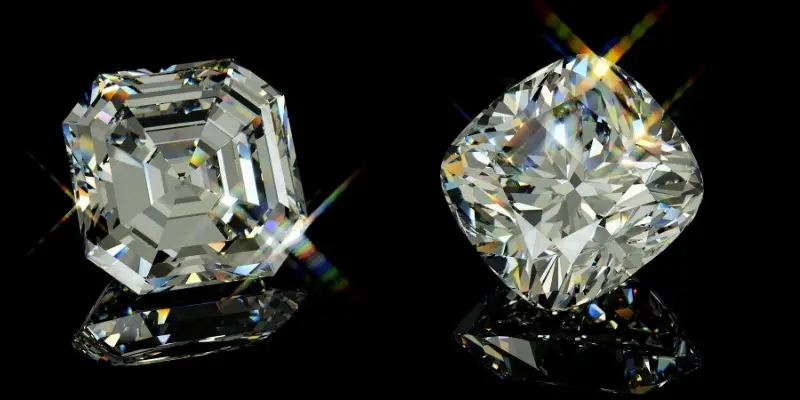
Cushion cuts have a more rounded, more organic feel to them. Their general shape is softer, not as sharp as an Asscher. They are great for halo settings and pave bands, but they also work great on their own as a solitaire.
A cushion cut may satisfy someone who isn’t sure whether they should go for a round or a square cut. It offers a pleasing middle ground between the round brilliant’s sparkle factor and the princess cut’s appealing shape. And if you’d like to try things out a bit, there is always the elongated cushion to try, which is just a bit longer than the traditional cushion cut.
2. Cushion cuts offer more sparkle than Asscher cuts
Cushion cuts have many variations but all of them manage to sparkle more than Asscher cuts. This is mostly due to the vastly different style of facets (brilliant instead of step-cut), how they’re angled, how deep the pavilion is and how tall the crown is. Overall cushion cuts offer more fire (rainbow light) and brilliance (white light) than an Asscher cut because the facets are arranged differently. This is true for all brilliant vs step-cut diamonds.
That being said, an Asscher will still sparkle for you, it will just do so differently. An Asscher cut has wider flashes of light, and it does have both fire and brilliance. It’s just that the shards of light are much bigger so they don’t appear as mesmerizing as a cushion cut.
Both cushion and Asscher cuts offer some sparkle, but as you can see they do this differently. Which you choose depends on what kind of look you’re going for.
3. Asscher cuts are a perfect square, cushion cuts are a bit skewed
The overall shape of the diamond may be very important to you and and it may help you with the final ring design. An Asscher cut is a perfect square, in that its length to width ratio is 1:1. Elongated Asscher cuts are very rare and may not even be patented.
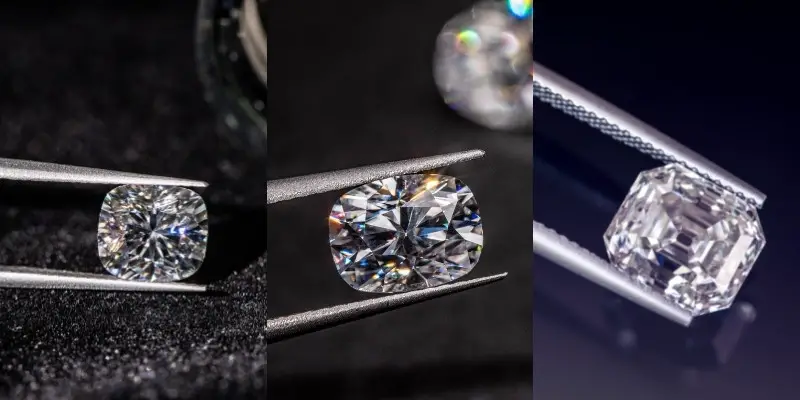
Cushion cuts appear square but are in fact a bit off-square. The traditional cushion cut has a 1:1.10 length to width ratio and some can go a bit longer than that. It’s not typical but you can still see elongated cushion cuts. In those cases it’s easy to confuse them for an oval cut diamond, as the proportions become similar.
In short if you’re confused about which diamond you’re looking at, or which you should get, know that Asschers are almost always perfect squares while cushions are just a bit elongated.
4. Cushion cuts have rounded corners, Asscher cuts have cut corners
Another wat to tell a cushion cut from an Asscher cut is their corners. An Asscher cut has straight edges and cut corners, forming a bit of an octagon shape. A cushion cut has rounded corner and rounded edges. This, coupled with the very angular look of an Asscher is an immediate giveaway of which diamond you’re looking at.
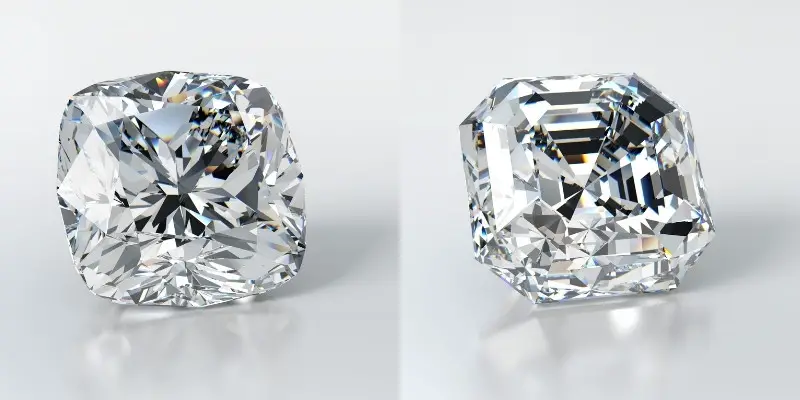
This difference can help you decide how you’d like to mount your diamond or whether you’d like a halo for it. For example adding prongs onto the corners of an Asscher will give it a squared look, especially fi it’s a single prong on each corner. Adding a halo to your Asscher will immediately soften those edges. A great way to keep you Asscher’s outline and still have a halo is to use baguette diamonds instead of round.
A cushion cut’s rounded and softer shape works differently with prongs, and at first glance it might seem like you’re wearing a round-cut instead of cushion. A closer look will reveal that it’s a cushion though. The same effect applies to halo settings.
5. Asscher cuts are rarer, less popular, more expensive than cushion cuts
If you’re leaning more towards Asscher cuts, know that you may have to keep searching for longer than you anticipated. These cuts are not as popular as other styles, and definitely not as popular as cushion cuts. This means several things.
You may have to compromise on quality or budget. An Asscher is a rare cut, and finding a good enough cut grade will matter more than anything. A poorly cut step-cut diamond will always look bad. This means color will be less important, but you should still keep in mind clarity.
It also means that you may have to see several jewelers or retailers until you have the Asscher diamond you like, that ahs the better cut grade and is still pleasing in terms of color and inclusion, and will still fit your budget.
The good news is that these diamonds tend to be lower in price, since there isn’t as much demand for them and the cut grade may not be excellent all the time. So compared to the very popular cushion cuts you might save a few thousand dollars.
And finally, your Asscher cut diamond will most likely be one-of-a-kind among your friends and relatives. This is not a common diamond cut so if you want to stand out, your Asscher will help you there. Just be mentally prepared for ‘oh it doesn’t sparkle as much’ comments, because these diamonds do not impress someone who lives for round brilliants. In the end it’s you who wears the diamond, so you have to like it, not anyone else.
6. Cushion cuts hide inclusions and color better than Asscher cuts
When you’re buying diamonds you have to be careful to balance your budget with the color grade, the clarity grade, and the cut grade as well.
When it comes to cushion cuts, these are your friends in regards to clarity and color. They are better at hiding color and inclusions than Asschers, as there are no large facets or windows through the diamond to showcase any flaws. Inclusions that are black or easily noticeable will will be visible in cushion cuts, and color grades lower than H will be visible.
But, an Asscher will not forgive any sort of inclusions so VVS1 and above is your best bet. Colors will show up starting with the G grade as well, so you will need a really good quality diamond for an Asscher.

I’m the main author for jewelrymaterialguide.com. I started this site after we did tons of research before our wedding and noticed that there is information about rings, jewelry, and so on that is really hard to find on the internet.
